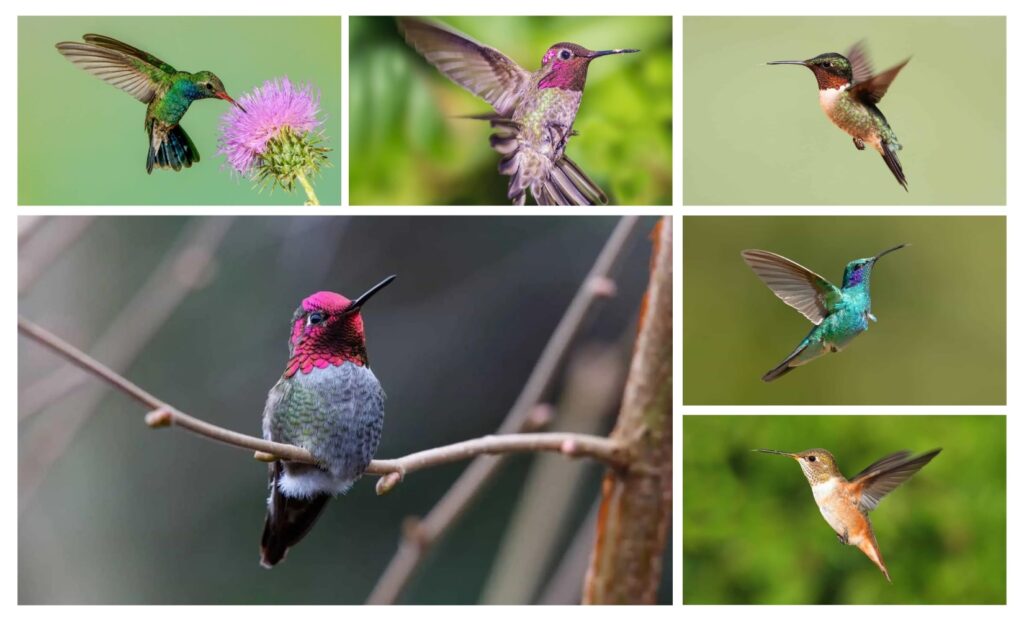Michigan is in the upper Midwestern United States, in the Great Lakes region. It is the 11th-largest state by area and the largest state east of the Mississippi River.
Bordering four of the five Great Lakes, Michigan has the longest freshwater shoreline globally and over 10,000 lakes! The water of the Great Lakes warms the cold winds of winter and cools the warm winds of summer, giving the state a moderate climate.
It’s no wonder then that Michigan has a large bird population, a wide variety of around 450 different species! Hummingbirds make up some of that number, and they are remarkable, tiny, brilliant flying creatures who glitter like jewels while they practice their aerial acrobatics.
Let’s take a look at some of the different types of hummingbirds you might see while in the state of Michigan.
Hummingbird Species In Michigan
There are eight species of hummingbirds on record for Michigan. Two of these are regular visitors, and six are accidental or rare visitors. Some have only been spotted once or twice in the state.
Ruby-Throated Hummingbirds
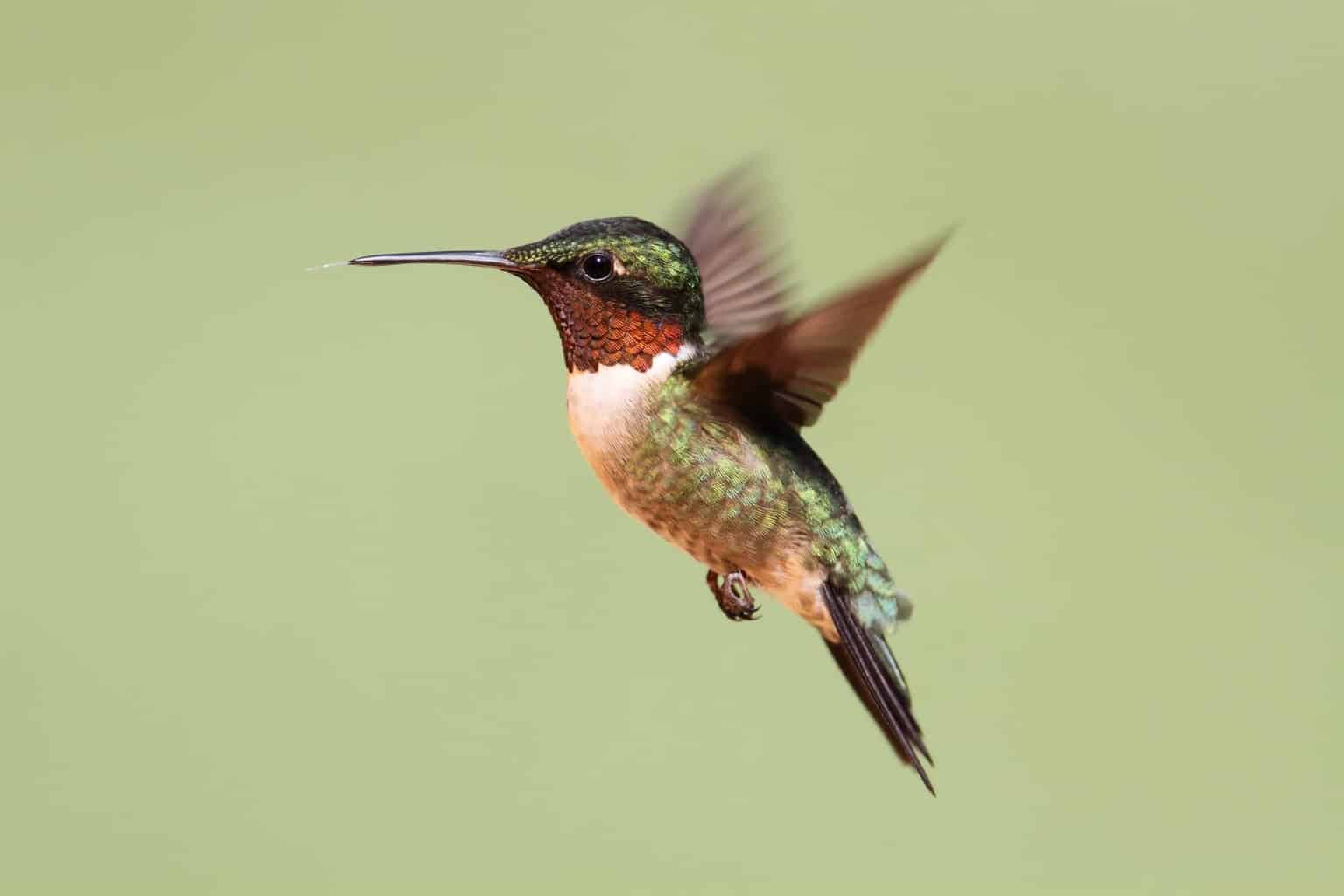
- Scientific Name: Archilochus colubris
- Length: 3 — 3.5 inches
- Weight: 0.1 — 0.2 ounces
- Wingspan: 3 — 4 inches
Description
The adult Ruby-throated hummingbird males have iridescent shades of ruby-red on their gorget (throat patch), narrowly bordered with velvety black on its upper margin. Its tail is forked, black with a faint violet sheen.
The female hummingbirds have white speckled throats, potentially with lightly marked stipples or dusky streaks. They have outer feathers banded in black, white, and green plumage and a notched tail.
Additional Information
The Ruby-throated Hummingbirds are natives to Michigan, arriving around the first week of May and leaving at the end of September.
These tiny birds will fly non-stop for 500 miles across the Gulf of Mexico during their migratory flight.
Ruby-throated hummingbirds are a familiar backyard bird and garden visitor in the summer, and they can become quite bold, visiting backyard feeders or a hanging plant next to your window or on your porch.
Rufous Hummingbirds
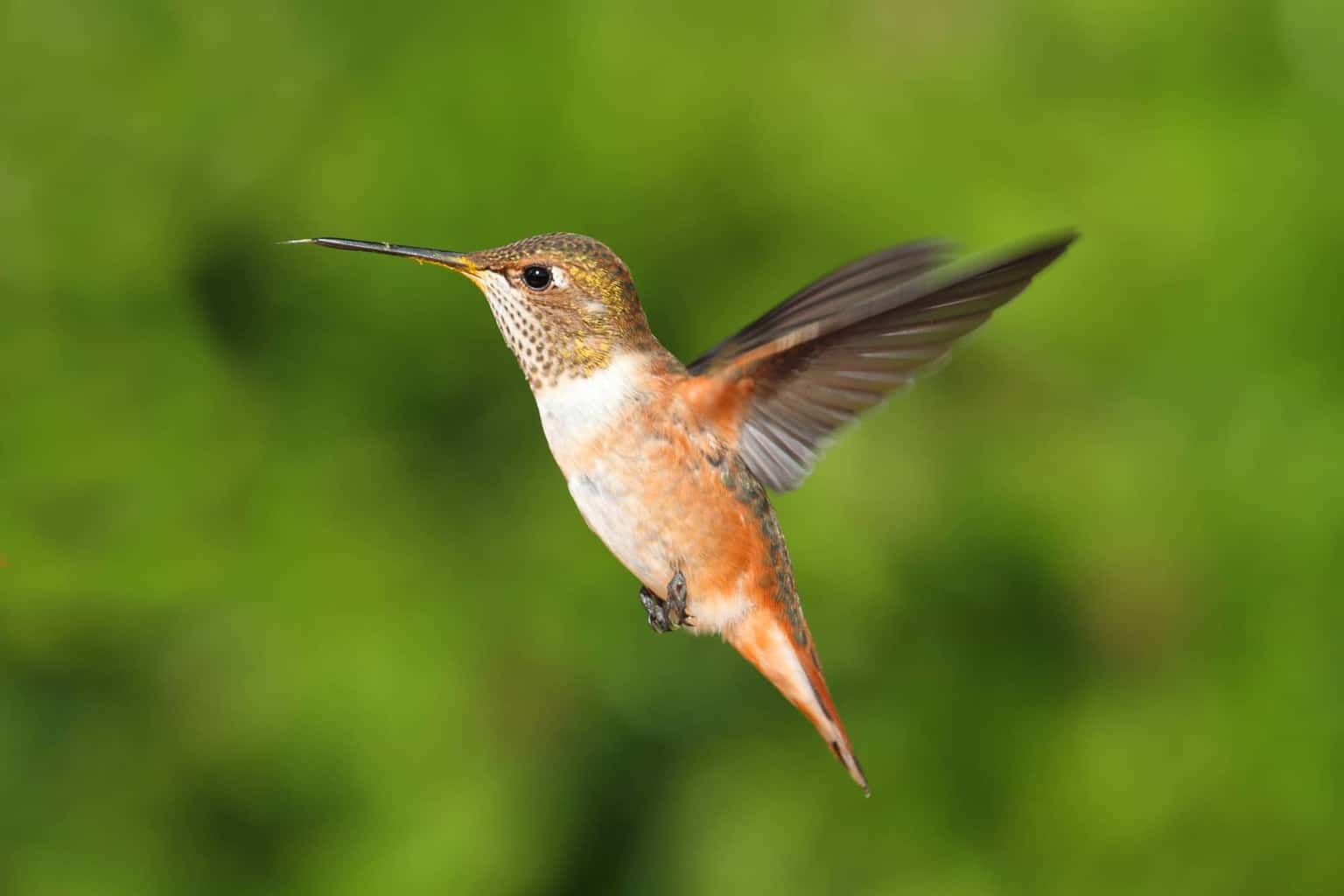
- Scientific Name: Selasphorus rufus
- Length: 3.5 – 4 inches
- Weight: 0.071 – 0.176 ounces
- Wingspan: 4.3 inches
Description
The adult male Rufous Hummingbird has a rufous (rusty orange) face, tail, and flanks; a white breast, a beautiful reddish-orange iridescent throat, and green backs. Their tail feathers are dark with a rufous base and white tips.
Female rufous hummers are slightly larger than the males, with greenish backs and rusty-washed flanks. They have green tails with rusty patches and, in many cases, a spot of orange on their throats.
Additional Information
These hummers are casual visitors to Michigan, and like Ruby-throated Hummingbirds, usually arrive in early May and leave around the end of September.
The Rufous Hummingbird makes the longest migration journey of any other hummingbird in the United States, potentially taking a trip of over 2,000 miles, crossing mountain forests and ranges as high as 12,600 feet.
They are also one of the feistiest hummingbird species in North America, relentlessly attacking other hummers and larger birds around a primary food source such as native plants and feeding stations, even if they don’t always win.
Broad-Billed Hummingbird
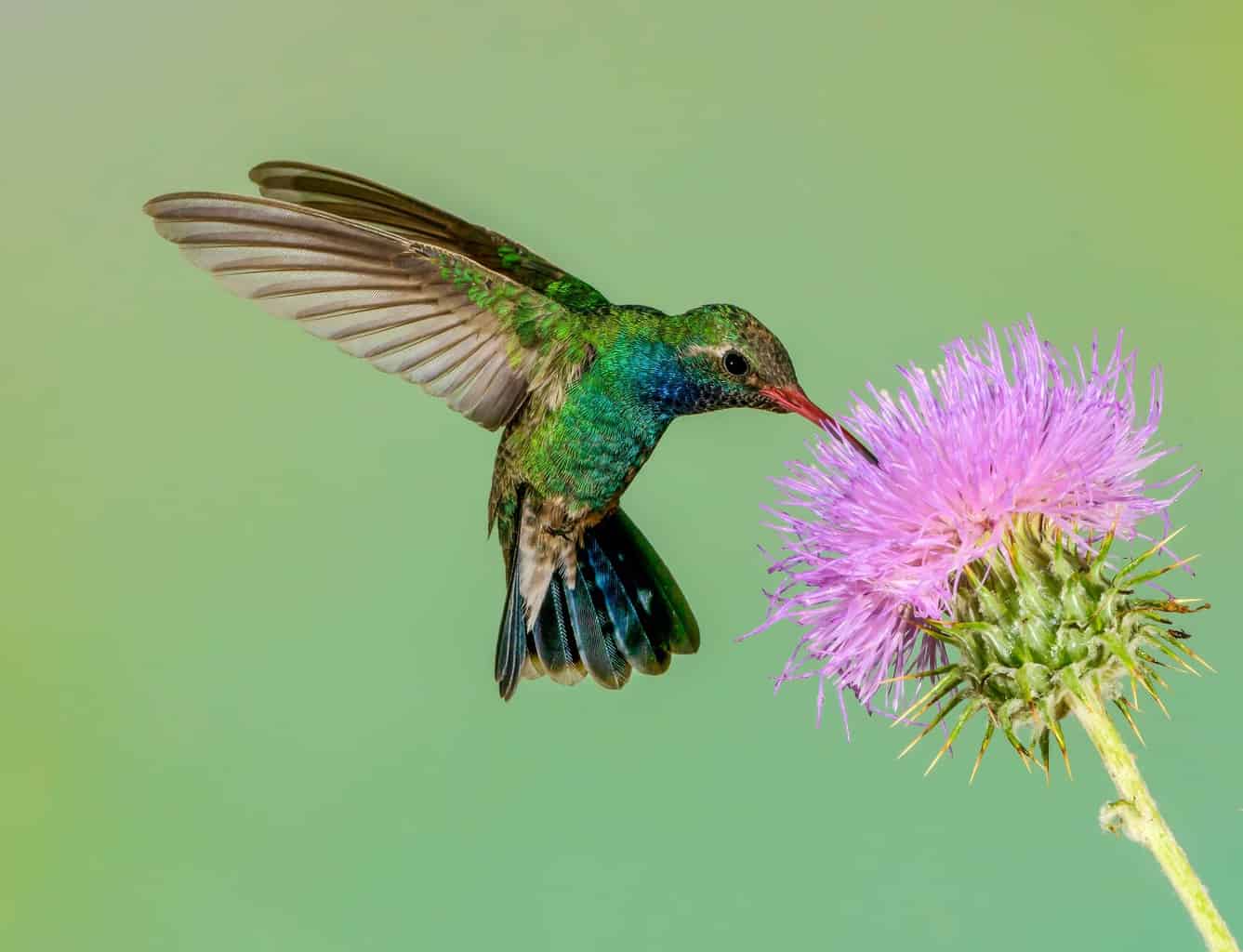
- Scientific Name: Cynanthus latirostris
- Length: 3.1 – 3.9 inches
- Weight: 0.10 – 0.14 ounces
- Wingspan: 5.1 inches
Description
The biggest similarity between the adult male and female Broad-billed Hummingbirds is their black-tipped red bill. Broad-billed hummers have metallic green backs with a duller coloring on their foreheads and crown.
The adult male has a brighter but shorter bill, with blue-black and broad tail; he also has a blue throat and brownish-grey flight feathers. The female has a white stripe behind her eye and a pale belly, with white-tipped tail feathers.
Additional information
The Broad-billed Hummingbird is an accidental vagrant in Michigan. If you are going to see one of these hummingbirds in Michigan, it will usually be between July and December.
They can be seen with their tails cocked, hovering close to tubular flowers using their extendible tongues for drinking flower nectar. You might also spot them hanging onto a flower while they are feeding.
During the breeding season, male Broad-billed Hummingbirds will hover a foot away from the female, flying back and forth in front of her like a pendulum as a courtship display.
Green Violetear Hummingbirds
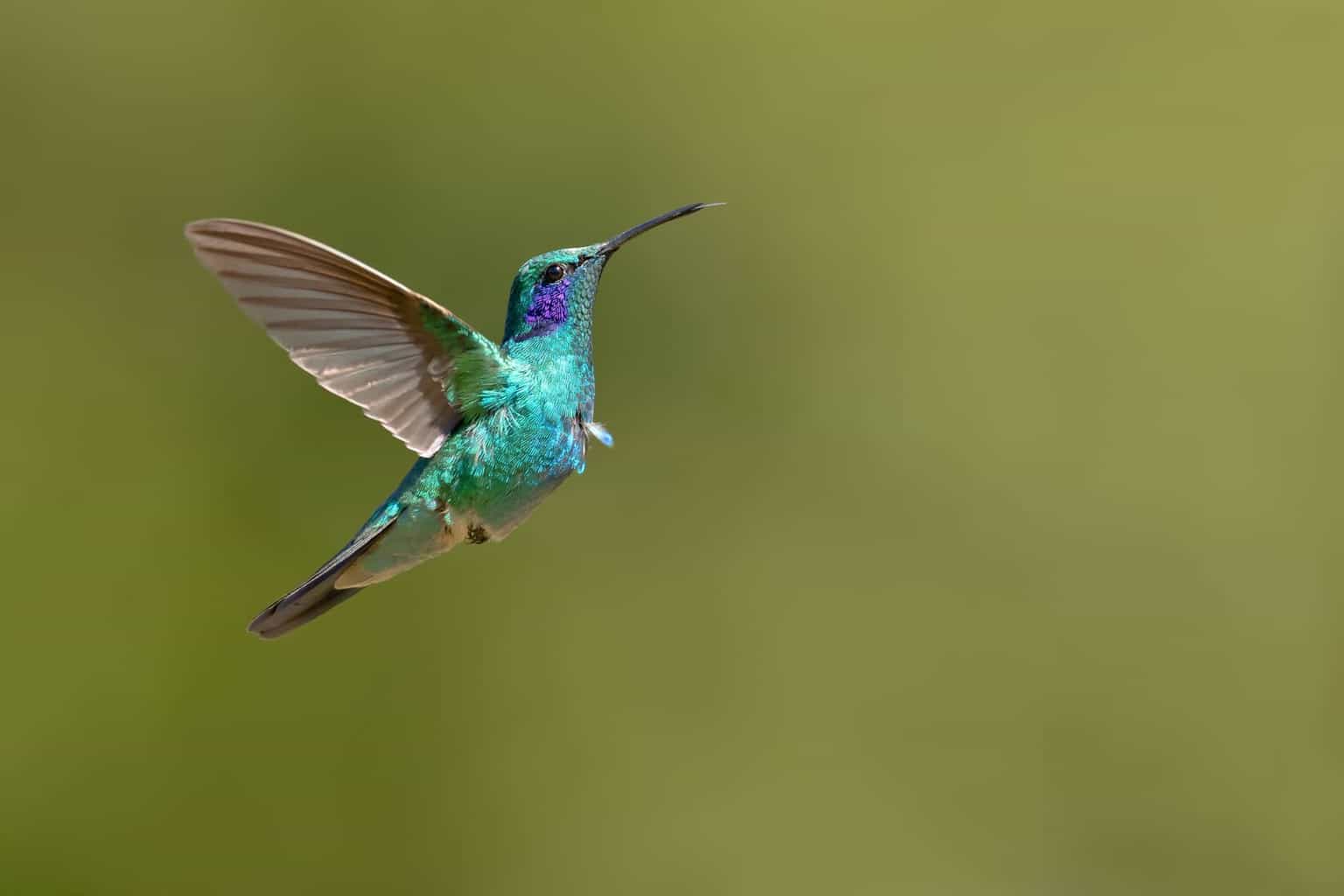
- Scientific Name: Colibri thalassinus
- Length: 2.5 – 4.5 inches
- Weight: 0.17 — 0.2 ounces
- Wingspan: 4.7 inches
Description
Both the male and female Green Violetear Hummingbirds are emerald green in color, with a slightly bronze coloration to their upper tail feathers and rumps. On their chins, they have a violet-blue band, which in some cases connects to their violet-blue ear patch on the sides of their necks.
Their tails are metallic green-blue, slightly notched, square-ish, and a dark blue bar near the end. Their bills are black and mostly straight, with a downward curve.
Additional Information
The Green Violetear Hummingbirds are accidental vagrants to Michigan, only being spotted two or three times in the summer months.
They mostly stay in their resident zones of Central America and Mexico. Although, they do have some seasonal movements and may wander north into the United States and even as far north as Canada.
They are also known as Mexican Violetear Hummingbirds, and they like to inhabit deciduous trees and scrubs in the semi-open upland country. Once males have established feeding territories, they will often aggressively chase away other males.
White-Eared Hummingbird
- Scientific Name: Basilinna leucotis
- Length: 3.9 — 5.4 inches
- Weight: 0.11 — 0.14 ounces
- Wingspan: 4 — 5 inches
Description
The similarities between the male and female White-eared Hummingbirds are green chests and upper plumage, primarily white under feathers and a dark straight tail — the female is duller than the male. They both have a distinctive white ear stripe, with the males one more boldly colored.
The adult males have a metallic green-blue throat, violet and black face, bronze-green tail, and a straight, short, very slender, red beak with a black tip. A broad blue-violet band encircles his beak at the base.
Additional Information
The White-eared Hummingbird is a rare accidental visitor to Michigan, having been spotted only once or twice in the state.
Their preferred habitats are pine-evergreen forests and clearings and mountain pine-oaks. They feed on nectar, small insects, and other small invertebrates.
Costa’s Hummingbird
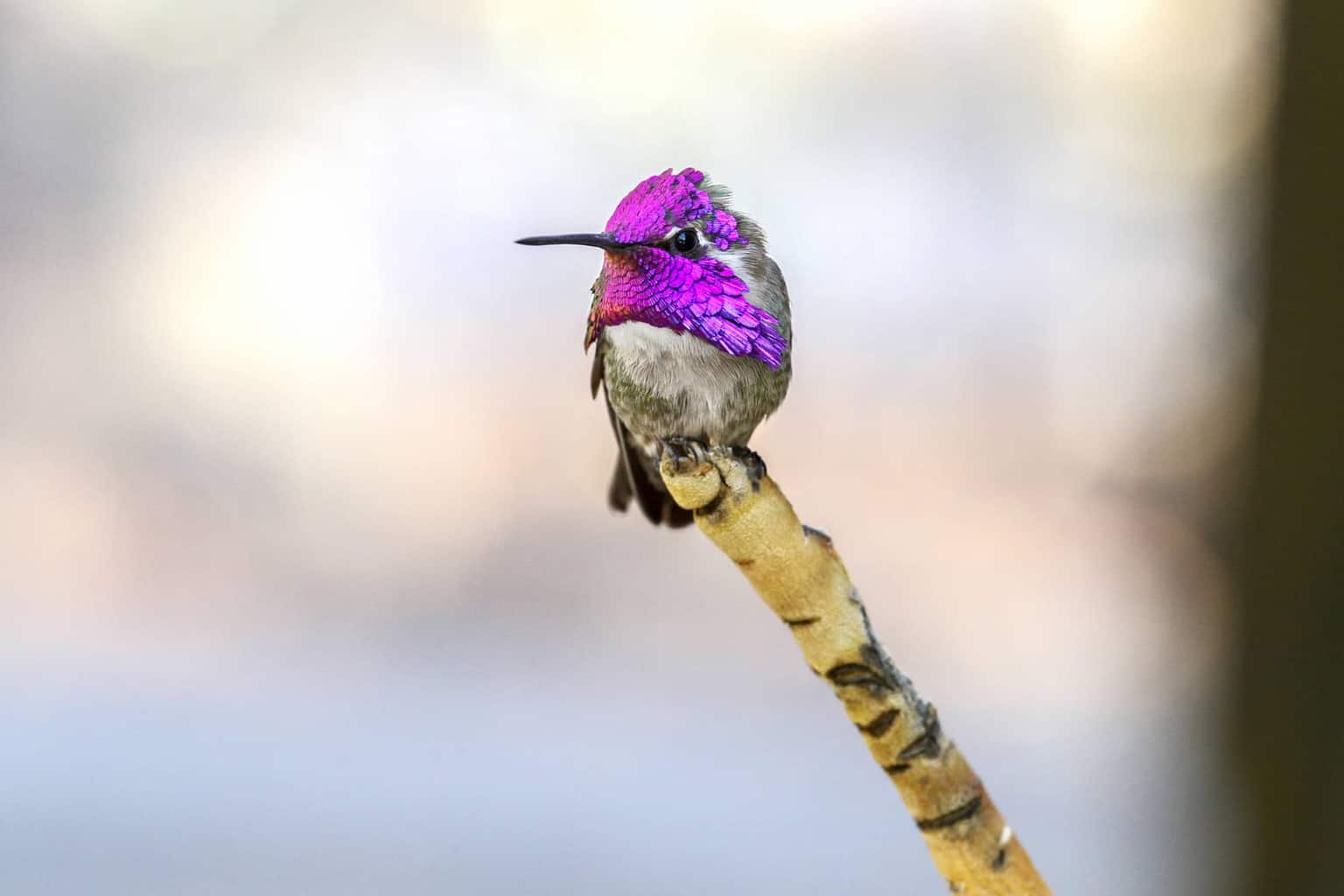
- Scientific Name: Calypte costae
- Length: 3–3.5 inches
- Weight: 0.11 ounces
- Wingspan: 3 inches
Description
The typical physical characteristics of the male and female Costa’s Hummingbirds are an iridescent green upper plumage, a dull black, straight, long bill, dark brown to black eyes, whitish underbelly, and greenish flanks.
The adult males’ iridescent purple-violet gorget (throat patch) and cap is his most distinguishing feature. The females’ throat is primarily white. More mature females may have a few dark/ purple feathers in the centers of their throats.
Additional Information
Costa’s Hummingbirds are rare vagrants to Michigan and have only been seen in the state once or twice.
These hummingbirds will vacate an area if their food supply runs dry or if the temperatures become too hot. When temperatures become too low at night, these hummingbirds can enter a torpid state by reducing their body temperatures and slowing their heart rates.
Anna’s Hummingbirds
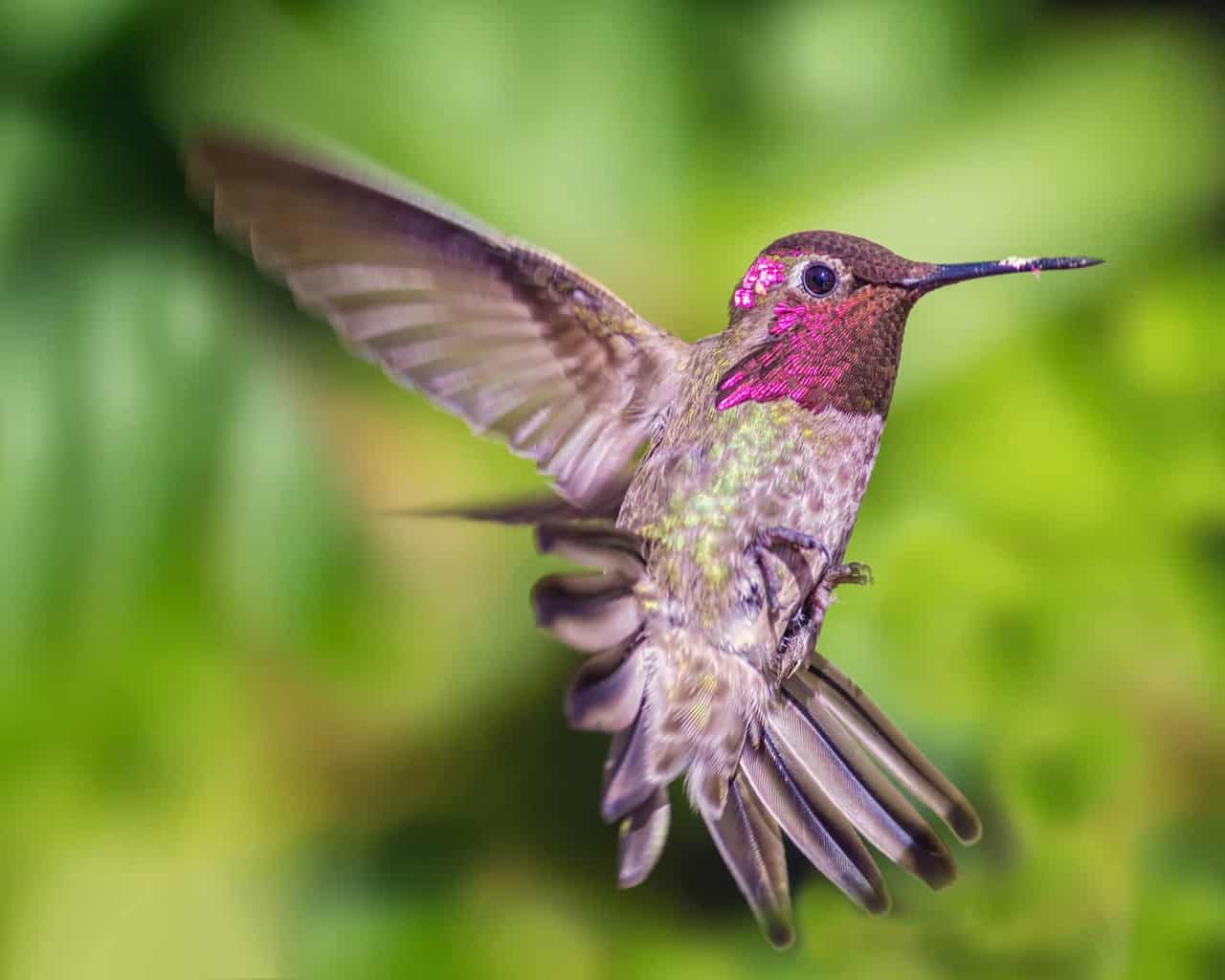
- Scientific Name: Calypte anna
- Length: 3.9 – 4.3 inches
- Weight: 0.1 – 0.2 ounces
- Wingspan: 7 inches
Description
The typical physical traits between the adult male and female Anna’s Hummingbird are their tube-shaped bodies, thin, long, straight bills, and a small white streak or spot behind the eyes. Their sides and back are a dark metallic green bronze, and their under plumage is grey mottled with green.
Adult males are easily recognizable by their distinctive reddish-colored gorget (throat patch) and forehead, with elongated feathers that project down the sides of their necks. Adult females have tufts on the sides of their rump, which are white; her throat is grey with red spots that intensify nearer the middle of her throat.
Additional Information
Only having been spotted a few times, Anna’s Hummingbird is a rare accidental visitor in Michigan during winter.
Anna’s Hummingbirds are one of three hummingbirds that are natives of Canada or the United States. They are also the only hummingbird that happily winters in the northern climates, as long as there are abundant flowers for them to feed.
Their territorial behavior is well known, with the adult male making elaborate dive displays protecting their food source from other birds and sometimes even people.
Berylline Hummingbird
- Scientific Name: Saucerottia beryllina
- Length: 3.1 – 3.9 inches
- Weight: 0.14 – 0.17 ounces
- Wingspan: 5.75 inches
Description
Both the adult males and females have a distinctive bright iridescent green-turquoise head, chest, and throat, which are a contrast against their darker cinnamon red tail and wings. Their tummies are whitish-grey to buff.
The Berylline Hummingbirds’ tails are dark with a purple-violet sheen to them, and their under tail feathers can sometimes show a rufous tinge. Their bills are slender and straight, with black upper bills and red-orange lower bills.
Additional Information
The Berylline rarely visits Michigan, with only one sighting on record in 2014, named after the sea-green gem beryl, whose dominant color closely resembles the gems’ coloration.
The favored habitats of the Berylline Hummingbird are oak woodlands, adjacent brushy thickets, foothills, and coffee plantations. Feeding at all levels, this hummingbird can be rather aggressive and chase other hummingbirds away from a good food source.
Conclusion
There are only two common species of hummingbirds that you can see in the state of Michigan. The other six are rare visitors; one of those six has only one recorded viewing in Michigan.
Even though there are not that many species of hummingbirds in this state, there are plenty of other beautiful birds to see in Michigan. Read this list to find out about 15 of the more striking and popular birds that you can see in Michigan.

